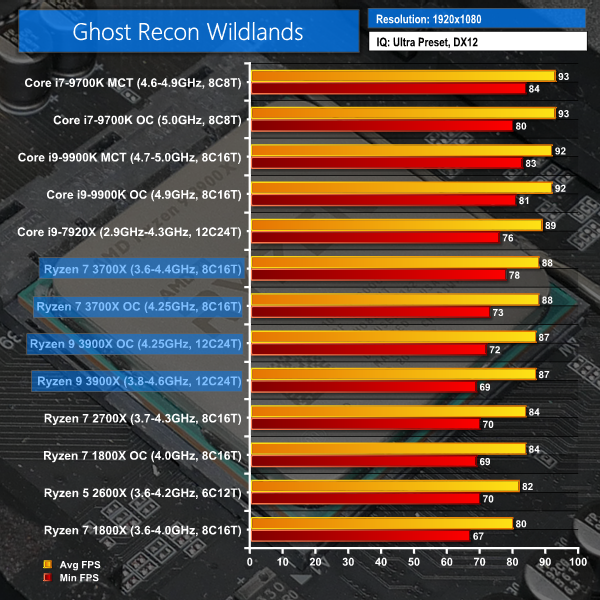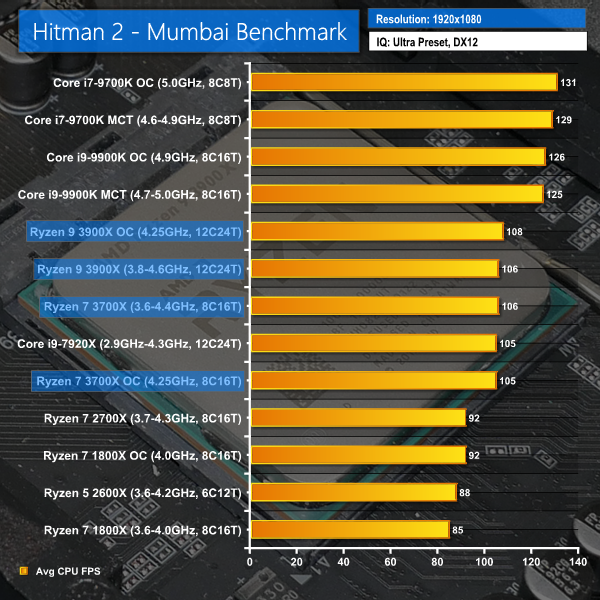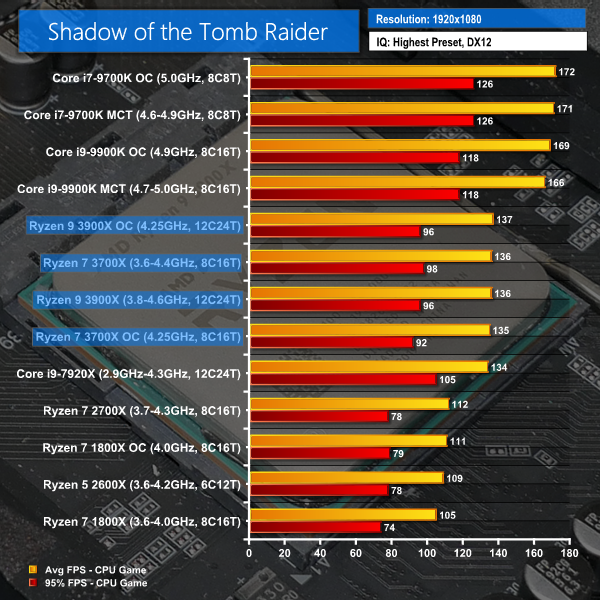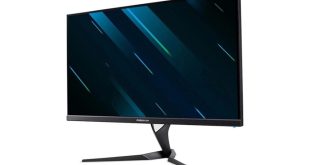Ghost Recon Wildlands
We run the built-in benchmark using a 1080P resolution and the Ultra quality preset.
Ghost Recon Wildlands is demanding on the GPU when using its ultra preset, even at 1080P. As such, we see little performance difference between all CPUs on show. Intel’s Coffee Lake chips still sit firmly at the top of the chart, partnered by the HEDT 7920X, with around 5% higher performance than the Ryzen 3000 processors.
Average CPU usage during the benchmark run was 27% for the 9900K compared to 20% for the Ryzen 9 3900X. Likewise, the 9700K required 37% CPU usage while the Ryzen 7 3700X averaged 27%. For game streamers, that increased free CPU capacity on the Ryzen 3000 CPUs may prove more useful than the 5% higher average frame rates on the Intel chips. Intel’s Coffee Lake competitors did, however, show consistently strong minimum FPS values.
Versus 3200MHz CL14 RAM, 3600MHz C16 DDR4 with the Ryzen 9 3900X delivers a 0.4% performance improvement for average FPS and a sizeable increase of 7.5% for minimum FPS in Ghost Recon Wildlands.
Hitman 2
We run the built-in benchmark using the Mumbai scene with image quality set to Ultra and the DirectX 12 mode enabled.
The performance increase from Zen and Zen+ to Zen 2 is less pronounced in Hitman 2 and, as such, the Ryzen 3000 performance deficit to Coffee Lake’s best sits around 15%. If you want to push past 120 FPS on average with a strong GPU such as our Aorus RTX 2080 Ti, Intel’s 9700K and 9900K are the best choices.
With that said, both Ryzen 3000 chips manage to offer frame rates higher than 105 on average, placing them in a performance section where even high refresh rate gamers would be happy enough with the FPS values attained. The same could not be said about Zen and Zen+, so AMD’s gaming improvements with Zen 2 prove worthwhile here.
Shadow of the Tomb Raider
We run the built-in benchmark using the DirectX 12 mode, anti-aliasing disabled, and the Highest quality preset.
The trend continues. Intel’s Core i7-9700K and i9-9900K place at the top of the performance chart in Shadow of the Tomb Raider. With average FPS values around the 170 FPS-mark, this is pushing to the point where the results are beyond what most people would aim for.
Both Ryzen 3000 chips manage excellent average frame rate values of more than 135 FPS, though the low values do drop below 100 FPS. It’s hard to complain about an average FPS of more than 135 FPS, even if Intel chips are around 25% faster. I struggle to see a scenario where even high refresh rate gamers will be disappointed by Ryzen 3000’s performance in a AAA title such as Shadow of the Tomb Raider. The same could not be said about the Ryzen predecessors so, again, AMD’s Zen 2 gaming improvements look to be worthwhile.
Versus 3200MHz CL14 RAM, 3600MHz C16 DDR4 with the Ryzen 9 3900X delivers a 3.9% performance improvement for average FPS and increases 95% FPS by 3.8%.
 KitGuru KitGuru.net – Tech News | Hardware News | Hardware Reviews | IOS | Mobile | Gaming | Graphics Cards
KitGuru KitGuru.net – Tech News | Hardware News | Hardware Reviews | IOS | Mobile | Gaming | Graphics Cards





